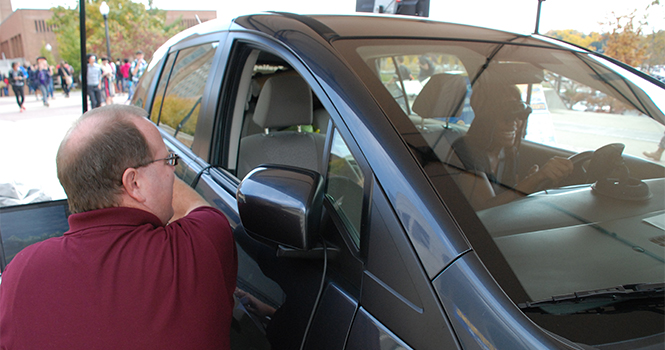Students encouraged to ‘Arrive Alive’ with accident demonstrations
Junior fashion merchandise major Gabby James attempted to “drive drunk” while “texting” for the Arrive Alive Tour as team leader Chris Seese monitored her driving outside the MACC October 17. Seese said college aged individuals are most prone to text and drive. Photo by Grace Jelinek.
October 18, 2012
Kent State students participated in hands-on, distracted driving demonstrations Wednesday as part of the “Arrive Alive Tour” to promote safe driving.
UNITE, a health and wellness organization based in Grand Rapids, Mich., held the demonstrations outside the MACC from 10 a.m. to 4 p.m. The message of the program is to heighten awareness about the dangers not only of drunk driving but also texting while driving, said UNITE spokesperson Chris Seese.
Students were invited to participate in mock driving scenarios where they were escorted inside a car and given virtual reality goggles, which allowed them to drive through a video game style course. It simulates the lowered response times and common distractions that drunk or distracted drivers would encounter in reality.
The demonstration used impact video and a high-tech simulator that allowed students to experience, in a controlled environment, the potential consequences of such behavior.
During the texting scenario, students were required to reply to an automated text message while attempting to proceed safely on the driving course. Tyler Westerman, sophomore public health major, had a collision in her simulation and hit a person walking across the street.
Westerman, who is against the practice because she knows someone who was killed by a driver who was texting, said the demonstration helped her further realize the dangers of texting while driving.
“It was scary,” Westerman said. “I just hit somebody, and I didn’t even notice it. I was completely just not even paying attention. It was a good experience.”
She said experiencing the driving simulation helped her want to encourage others to not text while driving.
LED televisions were set up outside of the vehicle to allow others to view the driver’s mishaps. There is also real-life footage of crash scenes displayed, showing students the potential results of distracted driving.
After the two-minute demonstration is completed, students are then given mock citations from the UNITE facilitators, noting all of the driving violations committed during their simulations such as crashes and victim injuries and fatalities.
Groups of students laughed and teased their friends as they watched them swerve and crash, and several students admitted how hard the demonstration was.
Erik Clarke, sophomore political science major, said he thought the demonstration would be easier.
“I didn’t expect the reaction time to be that bad,” Clarke said. “I’ve never driven drunk before, so it was a new experience.”
Clarke said he is strongly against drunk driving after his brother was involved in a wreck due to drunk driving. However, he did admit to texting — but only at stop lights.
Many students said they enjoyed the hands-on demonstration as opposed to other driving awareness programs.
“This is a great program because you’re not just sitting in a classroom, you’re actually learning information and experiencing it in a safe way.” Clarke said.
Contact Amanda Crumm at [email protected].

























